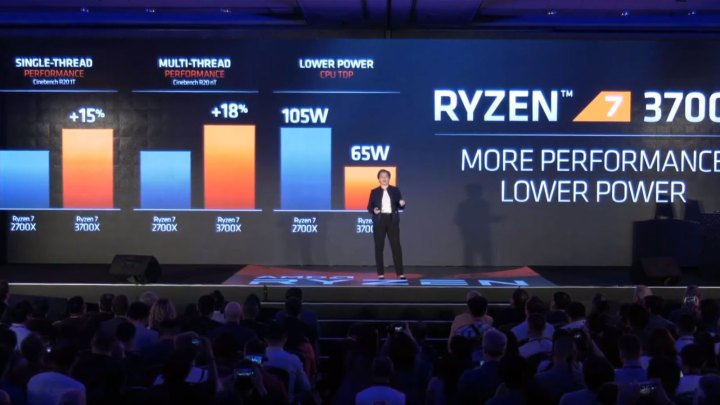If you love computer hardware, there was a lot to be excited for at this year’s Computex, with Intel and AMD announcing new generations of technologies on both the processor and graphical fronts. There was also talk of new partnerships, new artificial intelligence (A.I.) developments, and advancements in cloud computing and supercomputing that will see both firms make important steps in advancing a myriad of technologies in the years to come.
The question is, who did it better? Here’s a look at everything the two chip firms announced at Computex 2019 and a take on who had the most intriguing lineup.
Smaller CPUs

This is the year of the die shrink CPU. After years of Intel 14nm developments and incremental shrinks from AMD’s CPU lines, both chip firms announced major reductions in the size of their next-gen processors. AMD debuted most of its Ryzen 3000 series product line, which is based on 7nm Zen 2 cores, and Intel gave us our first look at its first volume 10nm technology in Ice Lake for mobile.
AMD was front and center at the commencement of Computex 2019, with CEO Dr Lisa Su taking to the stage to make a major keynote address. Among a myriad of exciting announcements, the third-generation Ryzen processors were arguably the biggest. She showcased the capabilities of the eight-core, 16-thread Ryzen 3700X, the higher-clocked 3800X, and the 12-core, 24-thread 3900X.
The Zen 2 architecture at the core of these CPUs increases the instructions per clock of Ryzen 3000 CPUs by 15 percent over Zen Plus Ryzen 2000 chips. That, combined with boosts to clock speed, larger caches, and improved memory latency, mean a large increase in single-threaded and multithreaded performance. First-party benchmarks from AMD suggest that the Ryzen 3000 series will be as capable as Intel’s ninth-generation in gaming and faster in productivity tasks by a significant margin. The high-end options can even beat some of Intel’s 9000-series HEDT chips that cost well north of $1,000.
They also have native support for PCIExpress 4.0, which will make AMD’s new X570 motherboard platforms the first to support the new, higher-bandwidth slot, potentially unlocking greater graphical power and much faster PCI Express storage drives.
These processors are set to go on sale on July 7, with prices starting at $200 and topping out at $500.
Although there was little mention of Threadripper at Computex, AMD did also reveal more details about its new Epyc Rome CPUs, the data center end of the Zen 2 spectrum. These chips will go on sale in the third quarter of 2019 and will offer up to 64 cores and 128 threads. They’re set to be used as part of a new Frontier supercomputer, which will, when completed, be the most powerful supercomputer in the world. AMD demoed the new server chips, beating Intel Xeon Cascade Lake CPUs in a NAMD Apo1 demo.

Intel’s CPU advancements were more limited and low-key, but nonetheless exciting. We finally got our first look at 10th-generation Ice Lake in the form of 10nm mobile CPUs that are now available in select laptops like Dell’s new XPS 13 2-in-1. Based on a new Sunny Cover architecture, these chips come in i3, i5, and i7 varieties, offering up to four cores and eight threads and clock speeds up to 4.1GHz. The die shrink and architectural improvements lead to an uplift in performance of as much as 2.5 times that of eighth-generation Whiskey Lake CPUs, we’re told.
There’s also added support for faster memory up to LPDDR4 at 3,733MHz and up to 32GB of it in supporting laptops. Ice Lake also includes hardware fixes for Spectre exploits, as well as integrated support for Wi-Fi 6 and Thunderbolt 3.
There are a handful of Ice Lake laptops available now, with 30 designs expected to debut before the 2019 holiday season.
Not to be entirely outdone on the desktop front, Intel also announced a special-edition CPU called the 9900KS, which is effectively a binned 9900K — like the special-edition 8086 — that can hit 5GHz on all cores. It will be a powerful chip, but details remain, thin with no news on its thermal design power (TDP) or pricing as of yet. It’s set to be released closer to the holidays.
Next-gen graphics

As Intel begins to ramp up its efforts in the graphics market, any generational advancements it makes are worth keeping an eye on, and Computex 2019 saw the reveal of its 11th generation, Iris Plus graphics. Included on die with the new Ice Lake CPUs, 11th-generation Intel Iris Plus graphics are impressively powerful 1080p gaming cores. They offer very playable framerates in esports titles like Counter-Strike: Global Offensive, Rocket League, and Fortnite, with between a 1.4 and 2 times improvement in performance over the GPU cores found in eighth-generation CPUs.
These onboard graphics cores won’t be as capable as dedicated graphics cards and chips, but should offer solid entry-level gaming options for those wanting to play on low-cost laptops and ultraportable systems. Perhaps most importantly, Intel 11th-gen graphics closes the performance gap between it and AMD’s APU Vega cores, which could make for a competitive battle between AMD and Intel-powered laptops toward the end of the year.

Although AMD does have 3000-series mobile APUs that it plans to launch in a wide range of laptops throughout the rest of the year, its graphics announcements at Computex were decidedly more powerful. Su’s keynote saw her unveil a new line of Navi graphics cards, after years of hints and teases.
Known officially as the RX 5700 series, these cards are a step in a new direction for AMD. It appears that RX 5700 GPUs are built on an entirely new architecture called Radeon DNA, or RDNA. It too is a 7nm process and will offer 1.25 times instructions per clock over previous GCN architectures like Vega, and up to 1.5 times performance per watt.
We weren’t given much detail on the product line, but we were shown a demonstration of an RX 5700 graphics card competing with an Nvidia RTX 2070 in Strange Brigade. That’s typically a strong title for AMD, however, so more benchmarks and third-party testing will be needed before we can make any judgments on its capabilities.
Set to go on sale on July 7 alongside the new Ryzen 3000 CPUs, the RX 5700-series will be fully unveiled at E3 in early June.
A.I. and the cloud

Machine learning is a hotbed of development in a wide variety of industries, and Intel is front and center in its advancement in the computing space. Ice Lake CPUs can enjoy a number of benefits thanks to its A.I. support, including optimizations for power consumption and performance to deliver greater battery life and improved thermal performance, which will help keep the processor running at the best speed for the workload required.
Other enhancements include automated screen-dimming depending on whether you’re looking at the screen or not, dynamically removing background noise from Voice over Internet Protocol (VOIP) calls, and removing motion blur when using a camera. All of it is based on personalized machine learning inference around the way the user interacts with their system.
Intel also leverages its smart technologies in the newly announced Intel performance Maximizer. It’s an intelligent overclocking tool that makes it easier than ever to enhance your processor’s capabilities based on its thermal and power headroom. It does this by tweaking and trying many frequencies and combinations of settings without needing to reboot and without the user needing to perform lengthy stability tests. It will be compatible with all ninth-generation K series desktop processors when it’s released in the near future.
A big part of AMD’s announcements during the opening Computex keynote was focused around partnerships. It’s working closely with motherboard manufacturers and laptop developers, but one of its biggest partnership discussions was with Microsoft on its Azure cloud platform. It highlighted the advancements made in Azure cloud computing performance thanks to its Epyc CPUs. In one instance, an unnamed Azure customer was said to have accelerated their tasks by up to 7,500 times thanks to Epyc.
More to come from AMD
There’s no doubt that Intel’s new Ice Lake CPUs and 11th-generation graphics are exciting advancements for Intel. They’re the first real chip reveals the company has made in 2019 and hold promise for the future potential of Intel laptops in the form of greater gaming ability, better efficiency, and improved battery life. But volume still appears to be quite low. The number of Ice Lake laptops can be counted on one hand and even though there are 30 coming before the end of the year, that’s quite a long wait for a broader array of choice.
AMD’s next-generation CPUs are available on mobile right now and will continue their rollout throughout the year, but it’s the desktop chips that will define 2019 for AMD. Ryzen 3000 CPUs could finally eclipse Intel as the best gaming processors in the world and look set to do it at a more than competitive price. AMD is pushing the envelope in graphics too, with RX 5700 cards potentially offering comparable performance to Nvidia’s best midrange offerings.
There’s still a lot we want to learn about AMD’s new technologies before we get too excited, but the potential is there and mere weeks away from release. In comparison, Intel’s advancements don’t appear very close at all, especially in terms of volume and choice.
2019 looks set to be another big year for AMD and Computex is just one more step on the path to what could well be a new era of leadership in the computing space.




